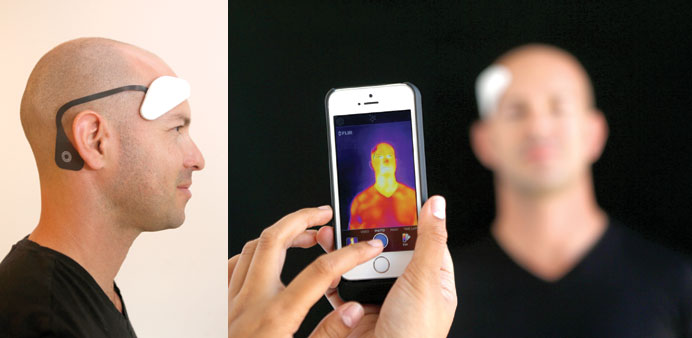EXPERIMENT: Dan Wetmore demonstrates Thync, a bluetooth connected wearable device. An electrode strip goes from the forehead to behind the ear or neck. Right: IN THE FRAME: Infrared photography can show how the device heats up areas of the face and neck.
By Heather Somerville
Grandmothers are wearing Fitbit, Jawbone bracelets pack the shelves of big-box stores and Apple’s smartwatch is expected to be one of the most coveted Christmas gifts this year.
Wearable technology — wireless-connected gadgets that come in the form of eyeglasses, bracelets, wristwatches and other small accessories for the body — have gone from nerdy and outlandish devices to popular purchases for the average consumer, a sign of how comfortable we have become with tracking our daily activities, whether it’s how well we sleep or how many calories we burn.
Now entrepreneurs are working to push the technology to new heights, creating gadgets that don’t simply collect data on the body but can alter the user’s physical and mental state. It’s a largely underexplored area that offers the potential to alleviate pain and improve brain functionality, but also carries a host of concerns about whether using startup technology to change our body chemistry poses unnecessary risks.
Thync, a startup based in the Bay Area town of Los Gatos, launched publicly early this month with a device that sends electricity to the user’s nerves to alter their mood and mental state. The user has two options: become calmer or more energised.
The mood-altering fix is delivered through a Bluetooth-connected headpiece, a strip attached to the neck or behind the ear to stimulate nerves that emerge directly from the brain, and a smartphone.
Leave your yoga mat or Red Bull at home.
“Are people looking for some sort of stimulant to alter their mental state? Unequivocally, yes,” said Luis Rincon, co-founder and CEO of Wearables.com, a research and review site. “So there absolutely is a consumer appetite for this, and that’s been the case for millenniums. What’s new is we are now entering a phase where technology can provide that stimulant.”
Mind and body manipulation can be scary terrain, but easy-to-use devices such as Fitbit have paved the way for wearables 2.0. With a growing market and explosion of new companies — not to mention the gorilla of consumer electronics storming onto the scene in April with the Apple Watch — companies such as Thync are looking to stand out from the crowd.
“All wearables today are trackers,” said Thync co-founder and CEO Isy Goldwasser. “Our wearable is working in synergy with the body.”
Other companies are going a step further to offer medical treatment or therapy. Massachusetts-based Quell, for instance, sells a wearable that uses electrodes to provide chronic pain relief for those with fibromyalgia, sciatica, arthritis and other ailments.
The Consumer Electronics Association predicts 10.8 million wearable devices will ship in 2015, up from more than 3 million last year.
Technology research firm Gartner predicts that 70 million to 100 million devices will be purchased in 2016. While not yet as ubiquitous as the smartphone, wearables are on their way.
Tech investors have thrown their collective hat in the wearable ring — to the tune of $635 million from July 2014 through June 1, according to PitchBook, a research and data provider.
That’s a nearly fourfold increase from the previous year, when
VCs invested $172 million in the space.
“That level of investment shows us that it’s not just a fad, and it’s something that’s going to be around for a long time,” Rincon said.
Thync has raised $13 million from investors including Khosla Ventures. Its founders, Jamie Tyler, a neuroscience expert and Arizona State University associate professor, and Goldwasser, a longtime tech executive, have spent the last year and a half testing the device on 3,500 people.
“We spent a very long time trying to beat the placebo effect,” Goldwasser said. “People can put it on and we don’t have any doubt that it’s working.”
They have tracked changes in users’ temperature, body chemistry and facial expressions — all of which are altered as electrical pulses from an iPhone are transmitted into the skin and through the nerves that act as superhighways to the brain.
The idea, the founders said, was to give busy people an alternative to alcohol or Red Bull — which many professionals use to wind down or rev up. The device starts at $299.
“Most people don’t meditate; most people don’t have the time,” Tyler said. “It’s sad, but that’s the world we live in.”
The San Jose Mercury News tried Thync, finding the “calm” vibrations did indeed have an effect: Breath slowed, anxiety disappeared, facial tension relaxed and worries gave way to a still mind.
But unlike meditation, the sensation arrived as an outside force and felt inauthentic, and therefore slightly unnerving. And the sedateness lasted only briefly — less than an hour — perhaps due to keeping the strength of the electrical stimulation at a minimum. These are, after all, electronic currents from a cellphone going directly into one’s forehead.
“It’s probably no more crazy than taking a bunch of supplements that you don’t really know anything about,” said Steve Holmes, Intel’s vice president of new devices. “But just to do it recreationally, I would be cautious.” — San Jose Mercury News/TNS



